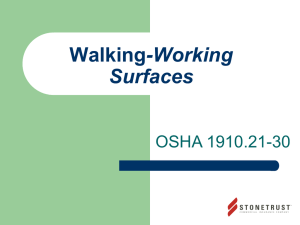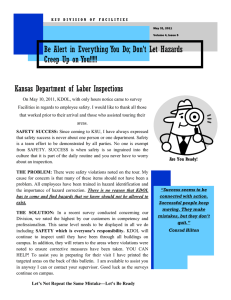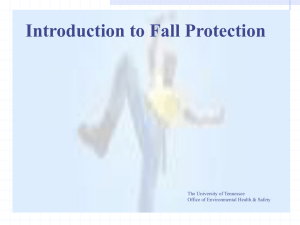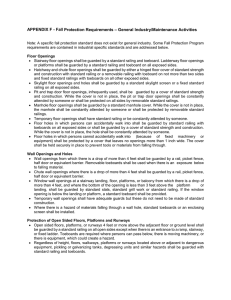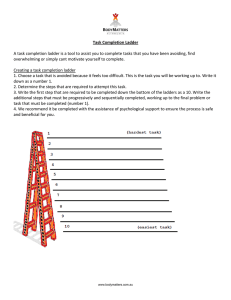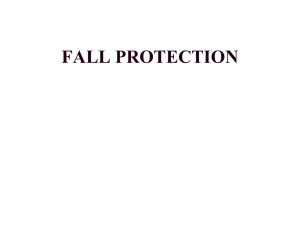NAU FS Safety and Health Policy and Procedure Manual
advertisement
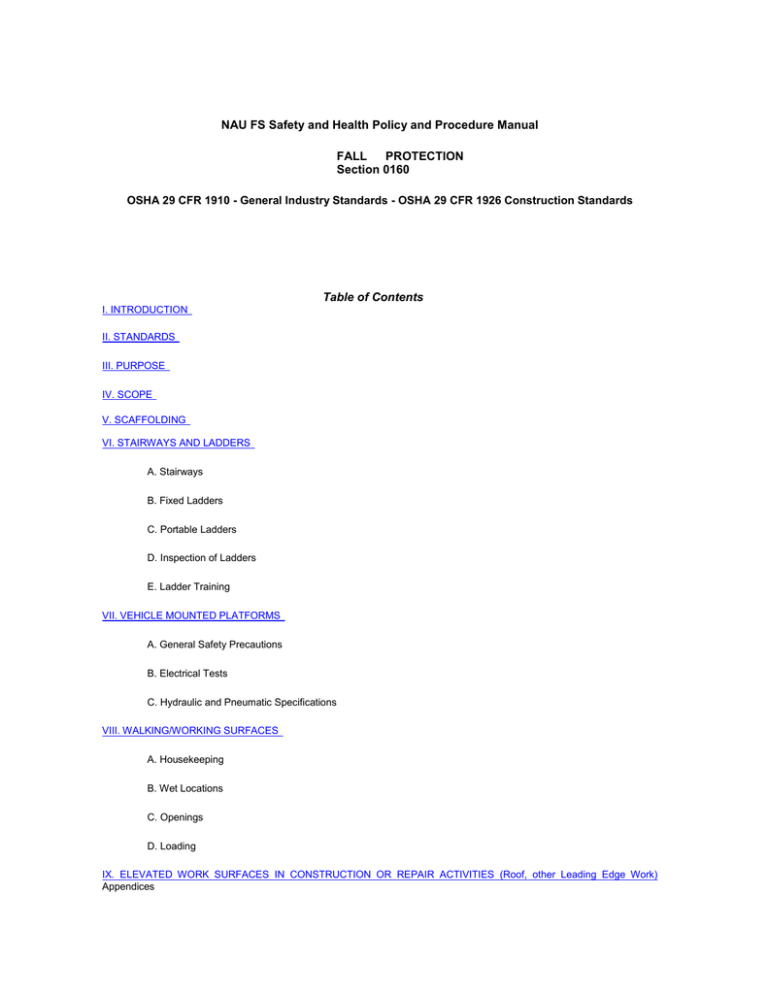
NAU FS Safety and Health Policy and Procedure Manual FALL PROTECTION Section 0160 OSHA 29 CFR 1910 - General Industry Standards - OSHA 29 CFR 1926 Construction Standards Table of Contents I. INTRODUCTION II. STANDARDS III. PURPOSE IV. SCOPE V. SCAFFOLDING VI. STAIRWAYS AND LADDERS A. Stairways B. Fixed Ladders C. Portable Ladders D. Inspection of Ladders E. Ladder Training VII. VEHICLE MOUNTED PLATFORMS A. General Safety Precautions B. Electrical Tests C. Hydraulic and Pneumatic Specifications VIII. WALKING/WORKING SURFACES A. Housekeeping B. Wet Locations C. Openings D. Loading IX. ELEVATED WORK SURFACES IN CONSTRUCTION OR REPAIR ACTIVITIES (Roof, other Leading Edge Work) Appendices A. Floor Inspection Checklist B. Fall Protection Training Roster C. Step Ladder Checklist D. Fixed Ladder Checklist SECTION 0160 I. INTRODUCTION According to National Safety Council Accident Facts, falls are the third leading cause of accidental deaths throughout the United States with about 12,000 deaths annually. Beginning about age 50, deaths due to falls begin increasing which indicates the need for increased fall protection programs for older persons at home and work. Once a person falls, the resulting injury, if any, usually depends on chance. Thus, a person falling from a 6-foot step ladder to the floor may receive no injury or may break his or her back. Obviously, the very best policy is to prevent falls in the first place. Falls may occur by a person slipping and falling to the floor on the same level or to a lower level. Some form of fall protection may be required at any height or on any surface. However, it is mandatory that persons working at heights at or above four feet be protected by some form of fall protection such as guardrails or safety harnesses. Throughout NAU there are many potential fall hazards which include, but are not limited to: work from ladders; work from elevated locations such as roofs and platforms; work from fixed equipment; climbing or descending stairs, tripping hazards in offices and labs; weather conditions which create hazardous walking situations; work from elevated platforms; any form of climbing including tree trimming, etc. II. STANDARDS OSHA 29 CFR 1910 - General Industry Standards • • • • • • • • • • .22 General Requirements .23 Guarding Floor and Wall Openings and Holes .24 Fixed Industrial Stairs .25 Portable Wood Ladders .26 Portable Metal Ladders .27 Fixed Ladders .28 Scaffolding .29 Manually Propelled Mobile Ladder, Stands and Scaffolds .30 Other Working Surfaces Subpart F - Powered Platforms, Manlifts, Vehicles Mounted Platforms OSHA 29 CFR 1926 Construction Standards • • • • • • • .104 Safety Belts, Lifelines, and Lanyards .105 Safety Nets .106 Working Over or Near Water .556 Aerial Lifts .1053 Ladders Subpart L - Scaffolding Subpart M - Fall Protection State of Arizona Uniform Building Code, Volume I III. PURPOSE The purpose of this policy is to protect employees from injuries resulting from slips, trips and falls. Where possible, fall prevention measures will be the primary means of protecting employees. IV. SCOPE This Policy and Procedure will cover exposures to falls from the following sources: • • • • • Scaffold Work Aerial Lifts Stairways & Ladders Work Surfaces in General Elevated Work Surfaces in Construction or Repair Activities (Roofs, other leading edge work.) V. SCAFFOLDING Scaffolds shall be used for persons engaged in work that cannot be done safely from the ground or from solid construction, except where ladders or lifts will provide adequate and safe work practices. Scaffolds shall be designed by a "Qualified Person" and shall be constructed and loaded in accordance with that design. A "Qualified Person" as defined by OSHA, will be one who by possession of a recognized degree, or professional standing, or who by extensive knowledge, training, and experience, has successfully demonstrated the ability to solve problems related to scaffold design and erection. It is recommended that an experienced degreed engineer or Professional Engineer, with experience in scaffolding be considered a "Qualified Person". The latest provisions contained in OSHA 1926 Subpart L shall be followed in the design, erection and use of scaffolding. A copy of which may be obtained from the Office of Safety. Additionally, the erection, moving, altering, or dismantling of scaffolding shall be under the supervision and direction of a "Competent Person" qualified in scaffolding, as defined by OSHA 1926 Subpart L. Employees performing such work must be supervised and trained, with documentation of training content forwarded to the Office of Safety. VI. STAIRWAYS AND LADDERS Stairways or ladders shall be provided at all working surfaces where there is a break in elevation of nineteen inches or more, and no ramp, runway, or sloped embankment. A. Stairways All stairs must be a minimum width of 44 inches, except for fixed industrial stairs, which may be a minimum of 22 inches, as permitted by code. Stair (Guard) rails will be provided on open sides of any steps that have four or more risers. The stair rail shall be between 36 inches and 42 inches in height, measured from the leading edge of the tread. Existing stair rails, installed before 1991, may be between 30 inches and 34 inches high, and should be updated as soon as feasible. Hand rails must be between 30 inches and 37 inches above the tread. Guard rails, used as handrails must be between 36 inches and 37 inches in height. Intermediate rails or guards on new installations shall be spaced such that a six inch diameter sphere cannot pass through any opening. Existing installation shall be modified as feasible correcting the most hazardous locations first. Mesh screening (smaller than would be required to prevent the passing of a 6 inch sphere) maybe required as protection of the intermediate spaces, if persons normally work or gather below stair sides. Special situations should be referred to the Office of Safety in determining the appropriate solution. B. Fixed Ladders Employees will be protected from falling from fixed ladders when the fall potential is 20 feet or more, by cages or ladder safety devices. Whenever a guardrail, stair railing, floor opening or secured hole cover will not provide the protection necessary to prevent a fall, the following devices must be provided and used: • • • Personal lifeline systems including harness, body belt and life line; or Safety nets; or Climbing protection systems, such as climbing safety devices used on fixed ladders when a cage cannot be used. Design and construction of all fixed ladders will be in accordance with OSHA 1910.27 & 1926.1053. Contact the Office of Safety for a copy of the latest version of this standard. Fixed ladders shall be inspected at least annually to insure stability and adequacy. C. Portable Ladders Three basic materials are used to make ladders, wood, aluminum and fiberglass. As wood ladders are more subject to wear and tear and thus failure, all new ladders purchased should be metal or fiberglass. Fiberglass ladders are preferred for most instances, as they do not conduct electricity and will help prevent accidental electrocutions. If special circumstances dictate that metal ladders are preferable, they shall be clearly marked "not for electrical work." Ladders should meet ANSI A14.2 for aluminum ladders and A14.5 for fiberglass ladders, and applicable OSHA standards. This should be specified when purchasing ladders. Site built ladders are not permitted. General Requirements for use of ladders include: • Portable ladders shall have non-conductive side rails if they are used where the employee or the ladder could contact exposed electrically energized parts. • The base of a non self-supporting (straight) ladder shall be placed so the distance from the base of the vertical support is one-fourth the working length of the ladder. • Damaged (bent or broken) ladders shall not be used. • Improvised repairs shall not be made to defective ladders. • The top of the ladder must be placed with the two rails supported, unless equipped with a single support attachment. • The employee shall use both hands and shall face the ladder when going up and down. • Any needed material shall be raised or lowered using a hand line. • Ladders shall not be moved, shifted, or extended while occupied. • Workers should not stand higher than the second rung from the top on a step ladder, or higher than the third rung on other ladders. • Ladders shall not be placed in front of doors opening toward the ladder unless the door access is blocked open, locked, or guarded, or access is blocked to prevent use. The area around the top and bottom of ladders shall be kept clear. • Ladders shall be placed to prevent slipping, and shall extend a minimum of 3 feet above the roof line or other work surface. • Ladders shall not be placed on boxes, barrels, vehicles, or other unstable bases to obtain additional height. • Ladders shall not be used on ice, snow, or other slippery surfaces unless suitable means are employed to prevent slipping. • If an employee must stand on a ladder and perform work at heights greater than six feet above another level, that employee shall either have a second person holding the ladder the entire time they are on the ladder, or shall wear approved fall protection equipment and be tied off with a lanyard secured to an approved attachment point (not to the ladder). • All portable ladders, except wood step ladders will be provided with slip resistant feet to prevent accidental displacement. • Ladders of proper length to reach the working height shall be selected. In addition, the ladder's manufacturers rated capacity shall not be exceeded. • Ropes on extension ladders shall be free from frayed or worn spots. • Upper sections of extension ladders shall overlap and rest on the bottom section. • Sections of extension ladders that are over 36 feet total length must overlap at least three feet. • Step-ladders shall be equipped with a metal spreader or locking device to securely hold the front and back sections in open position. • When used to gain access to a rooftop, the top of a ladder used should extend at least three feet above the point of contact. • Wooden ladders shall not be painted. • Where possible, a second person to hold the ladder should be used, especially on uneven ground. • Ladders shall be stored in safe, dry locations, and out of walkways to prevent tripping. D. Inspection of Ladders All ladders, both fixed and portable, require inspection. Ladders should be inspected prior to each use to insure their suitability for the work to be performed. Ladders must also be inspected whenever tipped over after any occurrence that affects their safe use. The person performing the inspection should use the checklists included as Appendices C & D. The person performing the inspections is authorized to remove the ladder from service by marking it "DANGEROUS, Do Not Use" and/or discarding it in the nearest adequate trash container. Periodic (quarterly) inspections shall be performed on all ladders, fixed and portable. The checklists included in Appendices C & D shall be used and the person performing the inspection is authorized to remove unsafe ladders from service. To show that the quarterly inspection has occurred, a color coded sticker or piece of tape should be placed on the inspected ladder's side rail. The employee inspecting the ladder shall initial and date the color coded sticker or tape. The color code is as follows: • • • • Blue - January, February, March Green - April, May, June Red - July, August, September White - October, November, December The department using the ladder is responsible for inspecting ladders under its control. E. Ladder Training Employees that use ladders shall be trained in hazard recognition and techniques that may be used to minimize risk to themselves. Training shall be conducted by a competent person and must include the following: 1 2 3 4 5 6 The nature of fall hazards The proper steps in the use of fall protection systems Placement and care of ladders Where to find load-carrying capacities with instruction not to exceed this rating Review of the Standard Retraining to be provided as necessary for thorough understanding and knowledge of ladder use. VII. VEHICLE MOUNTED PLATFORMS All vehicle mounted platforms, including extendible boom platforms, vertical towers and combinations thereof, shall be in compliance with ANSI A92.2-1969. Aerial lifts may not be field modified except by manufacturer. Any repairs must be made using original equipment, manufacturer parts. A. General Safety Precautions • Only personnel specifically trained shall operate aerial lifts • Prior to moving aerial lift vehicles, the ladder bucket and outriggers shall be stowed in place, with lifting devise in a zero energy state • Lift controls shall be tested each day prior to use to verify that proper and safe working conditions • Employees shall always stand firmly on the floor of the basket • Employees shall not sit or climb on the edge of the basket or use planks, ladders, or other devices for a work position • A body harness shall be worn with a lanyard attached to the boom or basket when working from an aerial. Attachment to adjacent structures, poles and/or equipment is prohibited. • Manufacturer specified load ratings shall not be exceeded • When in use, brakes shall be set and outriggers, if equipped, positioned on solid footing and wheels chocked • Aerial lifts shall not be moved when the boom is elevated and the basket is occupied unless the lift has been specifically designed for such operation. • Articulating boom and extendible boom platforms shall have dual controls, one control located in the operator basket, the other being located for use at ground level. Controls shall be readily marked with the lower control unit serving as the override. When the lift is occupied, ground level controls shall not be used without the operator's permission except in emergency circumstances. • Equipment may not be operated within ten feet of overhead high-voltage lines. Any fall protection equipment, including body harnesses, lanyards, and lifelines used to arrest an actual employee fall, shall be destroyed and replaced immediately following an incident. B. Electrical Tests Electrical tests shall be made in compliance with ANSI A92.2- 1969, Section 5 or in accordance with the manufacturer's recommendations C. Hydraulic and Pneumatic Specifications Critical components, such that a failure could result in a collapse or sudden movement shall be maintained in accordance with ANSI A92.2- 1969 Section 4.9 or in accordance with the original manufacturer's equipment and shall have a bursting safety factor of at least 2:1. VIII. WALKING/WORKING SURFACES Appendix A has been provided as a checklist to assist in improving the safety of walking/working surfaces. A. Housekeeping Rooms, offices, and storage spaces should be kept clean and orderly to prevent slips, trips, and falls. Hallways, aisles, and other travel paths should not have objects placed or stored in them for any reason. B. Wet Locations Floors shall be maintained, so far as possible, in a dry condition. Where wet processes are used, drainage, false floors, platform, mats, etc. should be used to provide dry work surfaces, as practical. When cleaning or other temporary situations cause floors to be wet, signs or other warning devices shall be used to warn of the hazard. C. Openings Every floor opening measuring twelve inches or more in its least dimension will be provided with a secured cover or a guardrail. Ladderway floor openings, hatchways, and chute openings must have guard rails and toeboards to protect employees when they are open. As these are infrequent situations, please contact the Office of Safety for specific requirements. Skylights must be guarded by guardrails or screening. Manholes or infrequently used trapdoors or pits shall be guarded by a cover. While the cover is not in place, the opening shall be protected by removable standard railings. Toeboards shall also be used if the space is to be entered. D. Loading Spaces used for industrial or storage purposes must be maintained so that loads do not exceed approved load ratings, as specified in design and approved by OSHA 1926.250. Load ratings should be posted and maintained in the affected area. IX. ELEVATED WORK SURFACES IN CONSTRUCTION OR REPAIR ACTIVITIES (Roof, other leading edge work) Elevated Work Surfaces include conditions not already mentioned in this policy such as roofs and leading edge construction activities. This type of work at NAU is generally performed by contractors or a few specialized maintenance employees. This type of work shall comply with the OSHA standards applicable, specifically 1926; Subpart M. Specific activities performed by NAU employees of this type shall be planned with the Office of Safety to insure safety and compliance. Note that these standards do not apply when employees are making inspection, investigation, or assessment of workplace conditions prior to or after actual construction/repair work. However, supervisory employees should insure all feasible protective devices or procedures are utilized during such time. Additionally, employees performing maintenance work on exhaust equipment, HVAC, plumbing, etc. should be protected from falls by means previously described, such as railings, permanent stairs or ladders, and work platforms. Any specialized situations should be addressed to the Office of Safety for recommendations. Appendix A, Section 0160 Northern Arizona University FLOOR INSPECTION MONTHLY CHECKLIST Date: _____ Inspected by: _____________________ Responsible Personnel: _______________________ Department: __________________ Location: ___________________ Area: _______________ General: Slips and falls are likely sources of workplace injuries. These injuries can and do occur when employees fall from open sided floors, fall through openings, as well as, slips and trips from improper floor surfaces. Floors must be properly designed and maintained to minimize the risk of employee falls. Note: Inspection checklists cannot possible cover all the items and situations which may be encountered in the workplace. Thus, thi sheet can only serve as a guide. Refer to the References on Page 5 for more information and details as well as other reference sourc N o INSPECTION ITEM . HOUSEKEEPING 1 All workplaces, passageways, storerooms, and service rooms are clean and orderly and in a sanitary condition. 2 Floors maintained clean and dry as possible with proper drainage, platforms, mats, provided for wet surfaces. 3 Floors free from protruding nails, bolts, splinters, holes, or loose boards. AISLES AND PASSAGEWAYS 4 When mechanical handling equipment is used, sufficient safe clearances shall be allowed for aisles, loading docks, doorways, and for turns. 5 Permanent aisles and passageways appropriately marked and kept clean. 6 Covers and guardrails provided for open pits, tanks, vats, ditches, etc. FLOOR LOADING PROTECTION 7 The loads approved by the building official shall be marked on plates conspicuously placed and properly maintained. 8 No load placed on any floor, roof, or other structure greater than that approved by the building official. GUARDING FLOOR OPENINGS AND HOLES Protection for floor openings (twelve inches or more in least dimension) 9 Stairway floor openings guarded with standard railings. 1 Every ladderway opening or platform guarded by a standard railing and 0 toeboard on all exposed sides. 1 Entrance guarded with a swinging gate or offset to prevent walking 1 directly into the opening. 1 Hatchways and chute openings guarded by hinged floor cover (guarded 2 when open) or removable railings with toeboards. 1 Skylight floor openings and holes guarded by standard screens or 3 railings. 1 Pits and trap door opening guarded by covers. 4 1 Manhole openings guarded by a standard cover. When cover is removed 5 and the opening not guarded, a person shall constantly guard the hazard. 1 6 Temporary opening guarded or a person in constant attendance. 1 Y ES N O COMMENT S Northern Arizona University FLOOR INSPECTION MONTHLY CHECKLIST Date: _____ Inspected by: _____________________ Responsible Personnel: _______________________ Department: __________________ Location: ___________________ Area: _______________ General: Slips and falls are likely sources of workplace injuries. These injuries can and do occur when employees fall from open sided floors, fall through openings, as well as, slips and trips from improper floor surfaces. Floors must be properly designed and maintained to minimize the risk of employee falls. Note: Inspection checklists cannot possible cover all the items and situations which may be encountered in the workplace. Thus, th sheet can only serve as a guide. Refer to the References on Page 5 for more information and details as well as other reference sourc N o INSPECTION ITEM Y N COMMENT . ES O S HOUSEKEEPING 1 All workplaces, passageways, storerooms, and service rooms are clean and orderly and in a sanitary condition. 2 Floors maintained clean and dry as possible with proper drainage, platforms, mats, provided for wet surfaces. 3 Floors free from protruding nails, bolts, splinters, holes, or loose boards. AISLES AND PASSAGEWAYS 4 When mechanical handling equipment is used, sufficient safe clearances shall be allowed for aisles, loading docks, doorways, and for turns. 5 Permanent aisles and passageways appropriately marked and kept clean. 6 Covers and guardrails provided for open pits, tanks, vats, ditches, etc. FLOOR LOADING PROTECTION 7 The loads approved by the building official shall be marked on plates conspicuously placed and properly maintained. 8 No load placed on any floor, roof, or other structure greater than that approved by the building official. GUARDING FLOOR OPENINGS AND HOLES Protection for floor openings (twelve inches or more in least dimension) 9 Stairway floor openings guarded with standard railings. 1 Every ladderway opening or platform guarded by a standard railing and 0 toeboard on all exposed sides. 1 Entrance guarded with a swinging gate or offset to prevent walking 1 directly into the opening. 1 Hatchways and chute openings guarded by hinged floor cover (guarded 2 when open) or removable railings with toeboards. 1 Skylight floor openings and holes guarded by standard screens or 3 railings. 1 Pits and trap door opening guarded by covers. 4 1 Manhole openings guarded by a standard cover. When cover is removed 5 and the opening not guarded, a person shall constantly guard the hazard. 1 6 Temporary opening guarded or a person in constant attendance. 1 7 Floor holes (less than twelve inches, more than one inch) guarded by Northern Arizona University FLOOR INSPECTION MONTHLY CHECKLIST Date: _____ Inspected by: _____________________ Responsible Personnel: _______________________ Department: __________________ Location: ___________________ Area: _______________ General: Slips and falls are likely sources of workplace injuries. These injuries can and do occur when employees fall from open sided floors, fall through openings, as well as, slips and trips from improper floor surfaces. Floors must be properly designed and maintained to minimize the risk of employee falls. Note: Inspection checklists cannot possible cover all the items and situations which may be encountered in the workplace. Thus, thi sheet can only serve as a guide. Refer to the References on Page 5 for more information and details as well as other reference sourc N o INSPECTION ITEM Y N COMMENT . ES O S HOUSEKEEPING 1 All workplaces, passageways, storerooms, and service rooms are clean and orderly and in a sanitary condition. 2 Floors maintained clean and dry as possible with proper drainage, platforms, mats, provided for wet surfaces. 3 Floors free from protruding nails, bolts, splinters, holes, or loose boards. AISLES AND PASSAGEWAYS 4 When mechanical handling equipment is used, sufficient safe clearances shall be allowed for aisles, loading docks, doorways, and for turns. 5 Permanent aisles and passageways appropriately marked and kept clean. 6 Covers and guardrails provided for open pits, tanks, vats, ditches, etc. FLOOR LOADING PROTECTION 7 The loads approved by the building official shall be marked on plates conspicuously placed and properly maintained. 8 No load placed on any floor, roof, or other structure greater than that approved by the building official. GUARDING FLOOR OPENINGS AND HOLES Protection for floor openings (twelve inches or more in least dimension) 9 Stairway floor openings guarded with standard railings. 1 Every ladderway opening or platform guarded by a standard railing and 0 toeboard on all exposed sides. 1 Entrance guarded with a swinging gate or offset to prevent walking 1 directly into the opening. 1 Hatchways and chute openings guarded by hinged floor cover (guarded 2 when open) or removable railings with toeboards. 1 Skylight floor openings and holes guarded by standard screens or 3 railings. 1 Pits and trap door opening guarded by covers. 4 1 Manhole openings guarded by a standard cover. When cover is removed 5 and the opening not guarded, a person shall constantly guard the hazard. 1 6 Temporary opening guarded or a person in constant attendance. 1 7 Floor holes (less than twelve inches, more than one inch) guarded by Appendix B, Section 0160 Appendix C, Section 0160 Northern Arizona University FLOOR INSPECTION MONTHLY CHECKLIST Date: _____ Inspected by: _____________________ Responsible Personnel: _______________________ Department: __________________ Location: ___________________ Area: _______________ General: Slips and falls are likely sources of workplace injuries. These injuries can and do occur when employees fall from open sided floors, fall through openings, as well as, slips and trips from improper floor surfaces. Floors must be properly designed and maintained to minimize the risk of employee falls. Note: Inspection checklists cannot possible cover all the items and situations which may be encountered in the workplace. Thus, thi sheet can only serve as a guide. Refer to the References on Page 5 for more information and details as well as other reference sourc N o INSPECTION ITEM . HOUSEKEEPING 1 All workplaces, passageways, storerooms, and service rooms are clean and orderly and in a sanitary condition. 2 Floors maintained clean and dry as possible with proper drainage, platforms, mats, provided for wet surfaces. 3 Floors free from protruding nails, bolts, splinters, holes, or loose boards. AISLES AND PASSAGEWAYS 4 When mechanical handling equipment is used, sufficient safe clearances shall be allowed for aisles, loading docks, doorways, and for turns. 5 Permanent aisles and passageways appropriately marked and kept clean. 6 Covers and guardrails provided for open pits, tanks, vats, ditches, etc. FLOOR LOADING PROTECTION 7 The loads approved by the building official shall be marked on plates conspicuously placed and properly maintained. 8 No load placed on any floor, roof, or other structure greater than that approved by the building official. GUARDING FLOOR OPENINGS AND HOLES Protection for floor openings (twelve inches or more in least dimension) 9 Stairway floor openings guarded with standard railings. 1 Every ladderway opening or platform guarded by a standard railing and 0 toeboard on all exposed sides. 1 Entrance guarded with a swinging gate or offset to prevent walking 1 directly into the opening. 1 Hatchways and chute openings guarded by hinged floor cover (guarded 2 when open) or removable railings with toeboards. 1 Skylight floor openings and holes guarded by standard screens or 3 railings. 1 Pits and trap door opening guarded by covers. 4 1 Manhole openings guarded by a standard cover. When cover is removed 5 and the opening not guarded, a person shall constantly guard the hazard. 1 6 Temporary opening guarded or a person in constant attendance. 1 Y ES N O COMMENT S Northern Arizona University FLOOR INSPECTION MONTHLY CHECKLIST Date: _____ Inspected by: _____________________ Responsible Personnel: _______________________ Department: __________________ Location: ___________________ Area: _______________ General: Slips and falls are likely sources of workplace injuries. These injuries can and do occur when employees fall from open sided floors, fall through openings, as well as, slips and trips from improper floor surfaces. Floors must be properly designed and maintained to minimize the risk of employee falls. Note: Inspection checklists cannot possible cover all the items and situations which may be encountered in the workplace. Thus, thi sheet can only serve as a guide. Refer to the References on Page 5 for more information and details as well as other reference sourc N o INSPECTION ITEM . HOUSEKEEPING 1 All workplaces, passageways, storerooms, and service rooms are clean and orderly and in a sanitary condition. 2 Floors maintained clean and dry as possible with proper drainage, platforms, mats, provided for wet surfaces. 3 Floors free from protruding nails, bolts, splinters, holes, or loose boards. AISLES AND PASSAGEWAYS 4 When mechanical handling equipment is used, sufficient safe clearances shall be allowed for aisles, loading docks, doorways, and for turns. 5 Permanent aisles and passageways appropriately marked and kept clean. 6 Covers and guardrails provided for open pits, tanks, vats, ditches, etc. FLOOR LOADING PROTECTION 7 The loads approved by the building official shall be marked on plates conspicuously placed and properly maintained. 8 No load placed on any floor, roof, or other structure greater than that approved by the building official. GUARDING FLOOR OPENINGS AND HOLES Protection for floor openings (twelve inches or more in least dimension) 9 Stairway floor openings guarded with standard railings. 1 Every ladderway opening or platform guarded by a standard railing and 0 toeboard on all exposed sides. 1 Entrance guarded with a swinging gate or offset to prevent walking 1 directly into the opening. 1 Hatchways and chute openings guarded by hinged floor cover (guarded 2 when open) or removable railings with toeboards. 1 Skylight floor openings and holes guarded by standard screens or 3 railings. 1 Pits and trap door opening guarded by covers. 4 1 Manhole openings guarded by a standard cover. When cover is removed 5 and the opening not guarded, a person shall constantly guard the hazard. 1 6 Temporary opening guarded or a person in constant attendance. 1 Y ES N O COMMENT S Submitted by: _______________________ Date: ___________ Time: ___________ Submitted to: _______________________ Assigned to: _____________ Date: ______ Northern Arizona University FLOOR INSPECTION MONTHLY CHECKLIST Date: _____ Inspected by: _____________________ Responsible Personnel: _______________________ Department: __________________ Location: ___________________ Area: _______________ General: Slips and falls are likely sources of workplace injuries. These injuries can and do occur when employees fall from open sided floors, fall through openings, as well as, slips and trips from improper floor surfaces. Floors must be properly designed and maintained to minimize the risk of employee falls. Note: Inspection checklists cannot possible cover all the items and situations which may be encountered in the workplace. Thus, this sheet can only serve as a guide. Refer to the References on Page 5 for more information and details as well as other reference sources. N o INSPECTION ITEM . HOUSEKEEPING 1 All workplaces, passageways, storerooms, and service rooms are clean and orderly and in a sanitary condition. 2 Floors maintained clean and dry as possible with proper drainage, platforms, mats, provided for wet surfaces. 3 Floors free from protruding nails, bolts, splinters, holes, or loose boards. Y ES N O COMMENT S AISLES AND PASSAGEWAYS 4 When mechanical handling equipment is used, sufficient safe clearances shall be allowed for aisles, loading docks, doorways, and for turns. 5 Permanent aisles and passageways appropriately marked and kept clean. 6 Covers and guardrails provided for open pits, tanks, vats, ditches, etc. FLOOR LOADING PROTECTION 7 The loads approved by the building official shall be marked on plates conspicuously placed and properly maintained. 8 No load placed on any floor, roof, or other structure greater than that approved by the building official. GUARDING FLOOR OPENINGS AND HOLES Protection for floor openings (twelve inches or more in least dimension) 9 Stairway floor openings guarded with standard railings. 1 Every ladderway opening or platform guarded by a standard railing and 0 toeboard on all exposed sides. 1 Entrance guarded with a swinging gate or offset to prevent walking 1 directly into the opening. 1 Hatchways and chute openings guarded by hinged floor cover (guarded 2 when open) or removable railings with toeboards. 1 Skylight floor openings and holes guarded by standard screens or 3 railings. 1 Pits and trap door opening guarded by covers. 4 1 Manhole openings guarded by a standard cover. When cover is removed 5 and the opening not guarded, a person shall constantly guard the hazard. 1 6 Temporary opening guarded or a person in constant attendance. Northern Arizona University FLOOR INSPECTION MONTHLY CHECKLIST 1 7 Floor holes (less than inches, more than oneResponsible inch) guarded by Date: _____ Inspected by:twelve _____________________ Personnel: _______________________ Department: __________________ Location: ___________________ Area: _______________ General: Slips and falls are likely sources of workplace injuries. These injuries can and do occur when employees fall from open sided floors, fall through openings, as well as, slips and trips from improper floor surfaces. Floors must be properly designed and maintained to minimize the risk of employee falls. ITEM N INSPECTION
